You are evaluating the security of VM1, VM2, and VM3 in Sub2.
For each of the following statements, select Yes if the statement is true. Otherwise, select No.
NOTE: Each correct selection is worth one point.

You assign User8 the Owner role for RG4, RG5, and RG6.
In which resource groups can User8 create virtual networks and NSGs? To answer, select the appropriate options in the answer area.
NOTE: Each correct selection is worth one point.
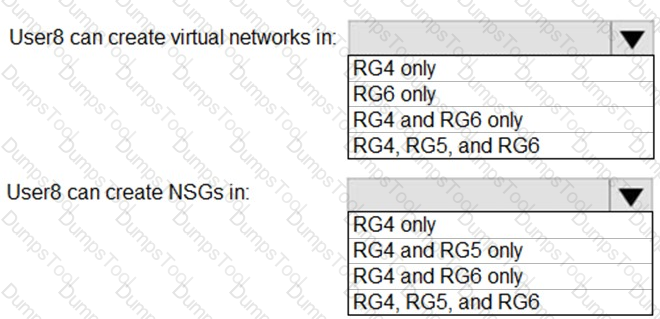
You need to delegate the creation of RG2 and the management of permissions for RG1. Which users can perform each task? To answer select the appropriate options in the answer area. NOTE: Each correct selection is worth one point
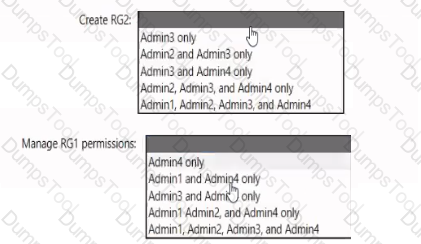
What is the membership of Group1 and Group2? To answer, select the appropriate options in the answer area.
NOTE: Each correct selection is worth one point.
You need to meet the technical requirements for the finance department users.
Which CAPolicy1 settings should you modify?
You plan to implement JIT VM access. Which virtual machines will be supported?
You implement the planned changes for ASG1 and ASG2.
In which NSGs can you use ASG1. and the network interfaces of which virtual machines can you assign to ASG2?

From Azure Security Center, you need to deploy SecPol1.
What should you do first?
You plan to configure Azure Disk Encryption for VM4. Which key vault can you use to store the encryption key?
You need to encrypt storage1 to meet the technical requirements. Which key vaults can you use?
You need to configure support for Azure Sentinel notebooks to meet the technical requirements.
What is the minimum number of Azure container registries and Azure Machine Learning workspaces required?
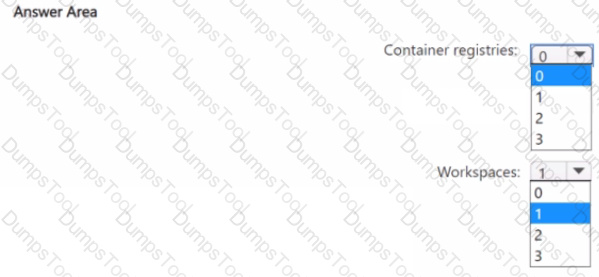
You have an Azure subscription. That contains the virtual machines shown in the following table.
You need to enable file integrity monitoring in Microsoft Defender for Cloud. Which computers will support file integrity monitoring?
You need to perform the planned changes for OU2 and User1.
Which tools should you use? To answer, drag the appropriate tools to the correct resources. Each tool may be used once, more than once, or not at all. You may need to drag the split bar between panes or scroll to view content.
NOTE: Each correct selection is worth one point.
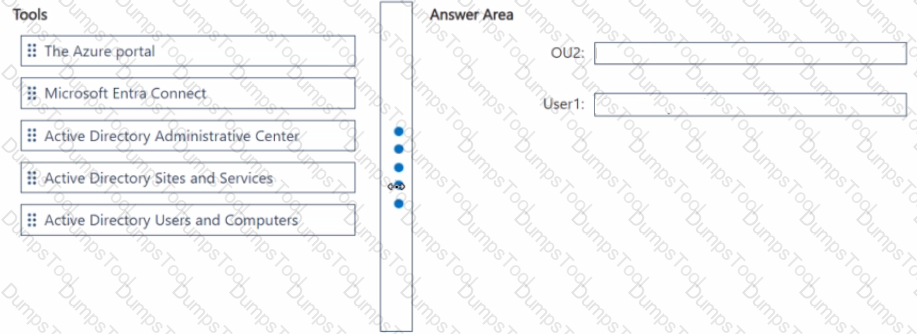
You have an Azure subscription that contains an Azure key vault and an Azure Storage account. The key vault contains customer-managed keys. The storage account is configured to use the customer-managed keys stored In the key vault.
You plan to store data in Azure by using the following services:
* Azure Files
* Azure Blob storage
* Azure Log Analytics
* Azure Table storage
* Azure Queue storage
Which two services data encryption by using the keys stored in the key vault? Each correct answer present a complete solution.
NOTE: Each correct selection is worth one point.
You have an Azure subscription that uses Microsoft Defender for Cloud.
You have an Amazon Web Service (AWS) account named AWS1 that is connected to defender for Cloud.
You need to ensure that AWS foundational Security Best Practices. The solution must minimize administrate effort.
What should do you in Defender for Cloud?
You have an Azure subscription and the computers shown in the following table.

You need to perform a vulnerability scan of the computers by using Microsoft Defender for Cloud. Which computers can you scan?
Note: This question is part of a series of questions that present the same scenario. Each question in the series contains a unique solution that might meet the stated goals. Some question sets might have more than one correct solution, while others might not have a correct solution.
After you answer a question in this section, you will NOT be able to return to it. As a result, these questions will not appear in the review screen.
You have an Azure Subscription named Sub1. Sub1 contains an Azure virtual machine named VM1 that runs Windows Server 2016.
You need to encrypt VM1 disks by using Azure Disk Encryption.
Which three actions should you perform in sequence? To answer, move the appropriate actions from the list of actions to the answer area and arrange them in the correct order.
You have an Azure Active Directory (Azure AD) tenant named contoso.com that contains the users shown in the following table.
Azure AD Privileged Identity Management (PIM) is enabled for the tenant.
In PIM, the Password Administrator role has the following settings:
Maximum activation duration (hours): 2
Send email notifying admins of activation: Disable
Require incident/request ticket number during activation: Disable
Require Azure Multi-Factor Authentication for activation: Enable
Require approval to activate this role: Enable
Selected approver: Group1
You assign users the Password Administrator role as shown in the following table.
For each of the following statements, select Yes if the statement is true. Otherwise, select No.
NOTE: Each correct selection is worth one point.

You have an Azure subscription that contains the following resources:
• An Azure key vault
• An Azure SQL database named Database1
• Two Azure App Service web apps named AppSrv1 and AppSrv2 that are configured to use system-assigned managed identities and access Database1
You need to implement an encryption solution for Database1 that meets the following requirements:
• The data in a column named Discount in Database1 must be encrypted so that only AppSrv1 can decrypt the data.
• AppSrv1 and AppSrv2 must be authorized by using managed identities to obtain cryptographic keys.
How should you configure the encryption settings fa Database1 To answer, select the appropriate options in the answer area.
NOTE: Each correct selection is worth one point
Lab Task
use the following login credentials as needed:
To enter your username, place your cursor in the Sign in box and click on the username below.
To enter your password. place your cursor in the Enter password box and click on the password below.
Azure Username: Userl -28681041@ExamUsers.com
Azure Password: GpOAe4@lDg
If the Azure portal does not load successfully in the browser, press CTRL-K to reload the portal in a new browser tab.
The following information is for technical support purposes only:
Lab Instance: 28681041
Task 2
You need to add the network interface of a virtual machine named VM1 to an application security group named ASG1.
You have a Microsoft Entra tenant that contains three users named User1, User2, and User3.
You configure Microsoft Entra Password Protection as shown in the following exhibit.
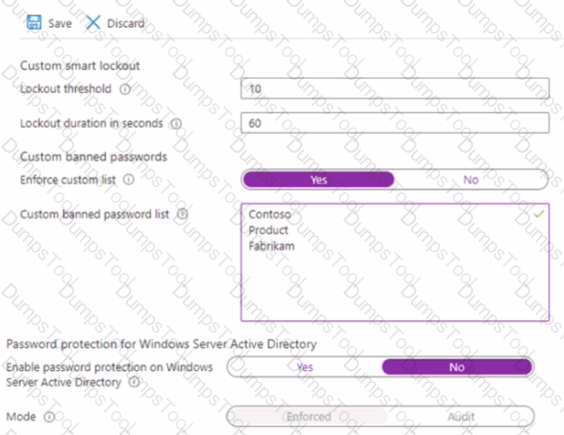
The users perform the following tasks:
• User1 attempts to reset her password to COntOsO
• User2 attempts to reset her password to F@brikamHQ
• User3 attempts to reset her password to PrOduct123.
Which password reset attempts fail?
Note: This question is part of a series of questions that present the same scenario. Each question in the series contains a unique solution that might meet the stated goals. Some question sets might have more than one correct solution, while others might not have a correct solution.
After you answer a question in this section, you will NOT be able to return to it. As a result, these
questions will not appear in the review screen.
You have an Azure Subscription named Sub1.
You have an Azure Storage account named Sa1 in a resource group named RG1.
Users and applications access the blob service and the file service in Sa1 by using several shared access
signatures (SASs) and stored access policies.
You discover that unauthorized users accessed both the file service and the blob service.
You need to revoke all access to Sa1.
Solution: You generate new SASs.
Does this meet the goal?
You have an Azure SQL Database server named SQL1.
You plan to turn on Advanced Threat Protection for SQL1 to detect all threat detection types.
Which action will Advanced Threat Protection detect as a threat?
You have an Azure subscription that contains an instance of Azure Firewall Standard named AzFWL You need to identify whether you can use the following features with AzFW1:
• TLS inspection
• Threat intelligence
• The network intrusion detection and prevention systems (IDPS)
What can you use?
You have a Microsoft 365 tenant that uses an Azure Active Directory (Azure AD) tenant The Azure AD tenant syncs to an on-premises Active Directory domain by using an instance of Azure AD Connect.
You create a new Azure subscription
You discover that the synced on-premises user accounts cannot be assigned rotes in the new subscription.
You need to ensure that you can assign Azure and Microsoft 365 roles to the synced Azure AD user accounts.
What should you do first?
You have an Azure Active Directory (Azure AD) tenant that contains the users shown in the following table.
From Azure AD Privileged Identity Management (PIM), you configure the settings for the Security Administrator role as shown in the following exhibit.
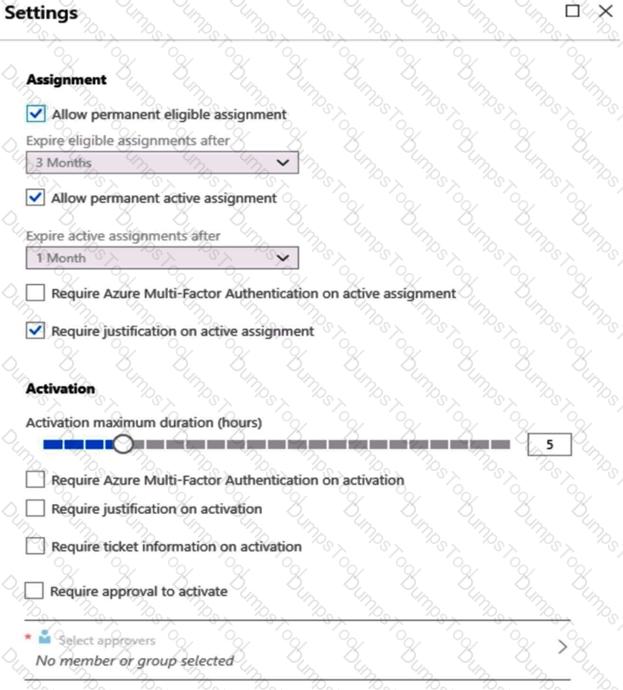
From PIM, you assign the Security Administrator role to the following groups:
Group1: Active assignment type, permanently assigned
Group2: Eligible assignment type, permanently eligible
For each of the following statements, select Yes if the statement is true. Otherwise, select No.
NOTE: Each correct selection is worth one point.

You have an Azure subscription that contains a web app named App1.
Users must be able to select between a Google identity or a Microsoft identity when authenticating to App1.
You need to add Google as an identity provider in Azure AD.
Which two pieces of information should you configure? Each correct answer presents part of the solution.
Each correct selection is worth one point
You have an Azure subscription that contains the resources shown in the following Table.

You plan to enable Microsoft Defender for Cloud for the subscription. Which resources can be protected by using Microsoft Defender for Cloud?
You have an Azure subscription that contains the virtual machines shown in the following table.
You create the Azure policies shown in the following table.
You create the resource locks shown in the following table.
For each of the following statements, select Yes if the statement is true. Otherwise, select No.
NOTE: Each correct selection is worth one point.
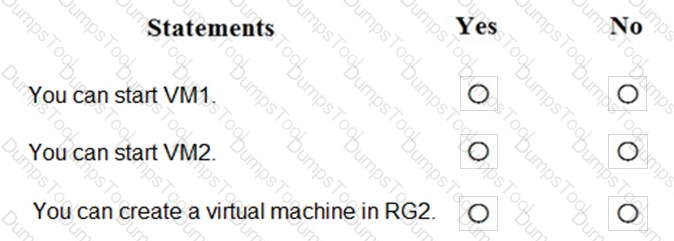
You have an Azure subscription named Sub1 that is associated to an Azure Active Directory (Azure AD)
tenant named contoso.com.
An administrator named Admin1 has access to the following identities:
An OpenID-enabled user account
A Hotmail account
An account in contoso.com
An account in an Azure AD tenant named fabrikam.com
You plan to use Azure Account Center to transfer the ownership of Sub1 to Admin1.
To which accounts can you transfer the ownership of Sub1?
You have a web app hosted on an on-premises server that is accessed by using a URL of https://www.contoso.com. You plan to migrate the web app to Azure. You will continue to use https://www.contoso.com. You need to enable HTTPS for the Azure web app. What should you do first?
Note: The question is included in a number of questions that depicts the identical set-up. However, every question has a distinctive result. Establish if the solution satisfies the requirements.
Your company has an Active Directory forest with a single domain, named weylandindustries.com. They also have an Azure Active Directory (Azure AD) tenant with the same name.
You have been tasked with integrating Active Directory and the Azure AD tenant. You intend to deploy Azure AD Connect.
Your strategy for the integration must make sure that password policies and user logon limitations affect user accounts that are synced to the Azure AD tenant, and that the amount of necessary servers are reduced.
Solution: You recommend the use of password hash synchronization and seamless SSO.
Does the solution meet the goal?
You have an Azure subscription named Subscription1 that contains the resources shown in the following table.
You need to identify which initiatives and policies you can add to Subscription1 by using Azure Security Center.
What should you identify?
Note: The question is included in a number of questions that depicts the identical set-up. However, every question has a distinctive result. Establish if the solution satisfies the requirements.
Your company has an Active Directory forest with a single domain, named weylandindustries.com. They also have an Azure Active Directory (Azure AD) tenant with the same name.
You have been tasked with integrating Active Directory and the Azure AD tenant. You intend to deploy Azure AD Connect.
Your strategy for the integration must make sure that password policies and user logon limitations affect user accounts that are synced to the Azure AD tenant, and that the amount of necessary servers are reduced.
Solution: You recommend the use of federation with Active Directory Federation Services (AD FS).
Does the solution meet the goal?
You have an Azure subscription named Sub1 that contains an Azure Storage account named Contosostorage1 and an Azure key vault named Contosokeyvault1.
You plan to create an Azure Automation runbook that will rotate the keys of Contosostorage1 and store them in Contosokeyvault1.
You need to implement prerequisites to ensure that you can implement the runbook.
Which three actions should you perform in sequence? To answer, move the appropriate actions from the list of actions to the answer area and arrange them in the correct order.
You need to ensure that you can meet the security operations requirements.
What should you do first?
You need to create Role1 to meet the platform protection requirements.
How should you complete the role definition of Role1? To answer, select the appropriate options in the answer area.
NOTE: Each correct selection is worth one point.
You need to ensure that the Azure AD application registration and consent configurations meet the identity and access requirements.
What should you use in the Azure portal? To answer, select the appropriate options in the answer area.
NOTE: Each correct selection is worth one point.
You need to meet the identity and access requirements for Group1.
What should you do?
You need to configure SQLDB1 to meet the data and application requirements.
Which three actions should you recommend be performed in sequence? To answer, move the appropriate actions from the list of actions to the answer area and arrange them in the correct order.
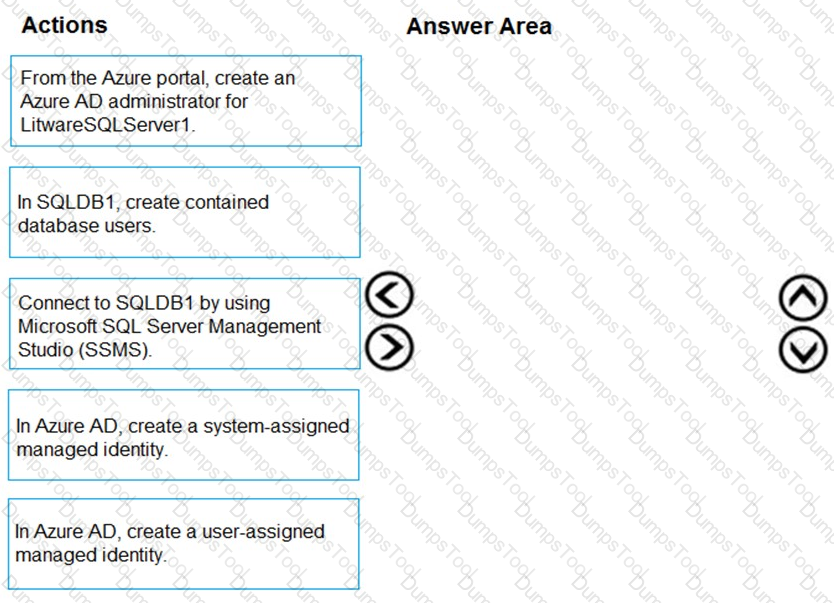
You need to deploy AKS1 to meet the platform protection requirements.
Which four actions should you perform in sequence? To answer, move the appropriate actions from the list of actions to the answer area and arrange them in the correct order.
NOTE: More than one order of answer choices is correct. You will receive credit for any of the correct orders you select.
You need to configure WebApp1 to meet the data and application requirements.
Which two actions should you perform? Each correct answer presents part of the solution.
NOTE: Each correct selection is worth one point.
You need to deploy Microsoft Antimalware to meet the platform protection requirements.
What should you do? To answer, select the appropriate options in the answer area.
NOTE: Each correct selection is worth one point.
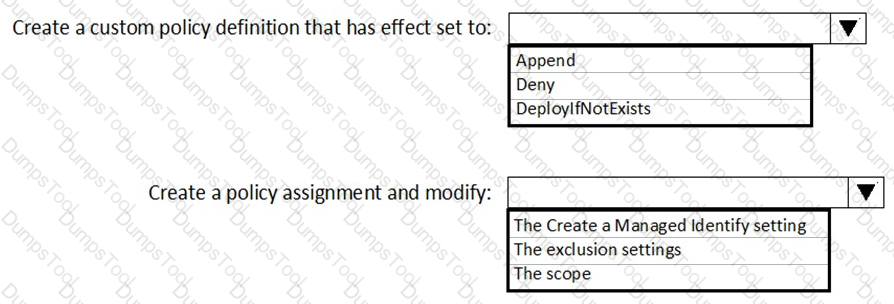
You need to ensure that users can access VM0. The solution must meet the platform protection requirements.
What should you do?